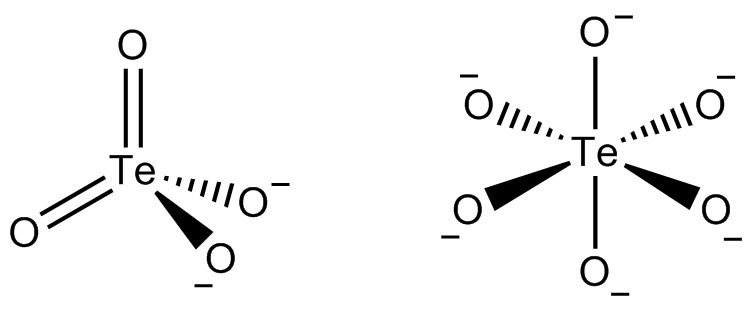 | ||
In chemistry tellurate is a compound containing an oxyanion of tellurium where tellurium has an oxidation number of +6. In the naming of inorganic compounds it is a suffix that indicates a polyatomic anion with a central tellurium atom.
Contents
Tellurium oxyanions
Historically the name tellurate was only applied to oxyanions of tellurium with oxidation number +6, formally derived from telluric acid Te(OH)6, and the name tellurite referred to oxyanions of tellurium with oxidation number +4, formally derived from tellurous acid (HO)2TeO and these names are in common use. However tellurate and tellurite are often referred to as tellurate(VI) and tellurate(IV) respectively in line with IUPAC renaming recommendations. The metatellurate ion is TeO2−
4 and the orthotellurate ion is TeO6−
6. Other oxyanions include pentaoxotellurate, TeO4−
5, ditellurate, Te
2O8−
10 and polymeric anions with 6-coordinate tellurium such as (TeO4−
5)n.
Metatellurates
The metatellurate ion TeO2−
4 is analogous to the sulfate ion, SO2−
4 and the selenate ion, SeO2−
4. Whereas many sulfates and selenates form isomorphous salts the tetrahedral metatellurate ion is only found in a few compounds such as the tetraethylammonium salt NEt4TeO4. Many compounds with a stoichiometry that suggests the presence of a metatellurate ion actually contain polymeric anions containing 6-coordinate tellurium(VI), for example sodium tellurate, Na2TeO4 which contains octahedral tellurium centers sharing edges.
4 → TeO2−
3 + 1⁄2 O2 (E0 = −1.042 V)
The E0 or standard reduction potential value is significant as it gives an indication of the strength of the tellurate ion as an oxidizing agent.
Orthotellurates
Compounds containing the octahedral TeO6−
6 anion are known, these include Ag6TeO6, Na6TeO6 and Hg3TeO6. There are also hydroxyoxotellurates, containing protonated TeO6−
6, such as (NH4)2TeO2(OH)4 (sometimes written as NH4TeO4·2H2O) which contains the octahedral TeO
2(OH)2−
4 ion.
TeO4− 5 ion
The compound Cs2K2TeO5 contains TeO4−
5 ions which are trigonal bipyramidal. The compound Rb6Te2O9 contains both TeO4−
5 and TeO2−
4 anions. Other compounds whose stoichiometry suggests the presence of TeO4−
5 may contain either the dimeric Te
2O8−
10 made up of two edge-sharing {TeO6} as in Li4TeO5 and Ag4TeO5 or corner-sharing {TeO6} octahedra as in Hg2TeO5.
Polymeric tellurate ions
The dimeric Te
2O8−
10 made up of two edge sharing {TeO6} octahedra is found in the compound, Li4TeO5. A similar hydroxy-oxy anion, Te2O6(OH)4 is found in sodium potassium ditellurate(VI) hexahydrate,Na0.5K3.5Te2O6(OH)4·6H2O which contains pairs of edge sharing octahedra. Polymeric chain anions consisting of corner-shared {TeO6} octahedra (TeO5)4n−
n are found, for example in Li4TeO5.
Aqueous chemistry
In aqueous solution tellurate ions are 6 coordinate. In neutral conditions the pentahydrogen orthotellurate ion, H
5TeO−
6, is the most common; in basic conditions, the tetrahydrogen orthotellurate ion, H
4TeO2−
6, and in acid conditions, orthotelluric acid, Te(OH)6 or H6TeO6 is formed.
Structural comparisons with oxyanions of sulfur and selenium
Sulfur(VI) oxyanions have a coordination number of 4 and in addition to the tetrahedral sulfate ion, SO2−
4, the pyrosulfate, S
2O2−
7, trisulfate, S
3O2−
10 and pentasulfate S
5O2−
16 ions all contain 4-coordinate sulfur and are built from corner-shared {SO4} tetrahedra. Selenate compounds include many examples of four coordinate selenium, principally the tetrahedral SeO2−
4 ion and the pyroselenate ion, Se
2O2−
7 which has a similar structure to the pyrosulfate ion. Unlike sulfur there are examples of a 5-coordinate selenium oxyanion, SeO4−
5 and one example of SeO6−
6.
NMR spectroscopy
Tellurium has two NMR active nuclei, 123Te and 125Te. 123Te has an abundance of 0.9% and a nuclear spin (I) of 1⁄2. 125Te has an abundance of 7% and an equivalent nuclear spin. 125Te is more commonly performed because it has a higher sensitivity. The metatellurate anion has a chemical shift around 610 ppm when analyzed using 125Te NMR at 25 °C at a frequency of 94.735 MHz and referenced externally against aqueous 1.0 M telluric acid.
The tellurate suffix in the naming of inorganic compounds
Following the IUPAC Red Book(2005) some examples are:
4 is tetraoxidotellurate(2–)
6 is hexaoxidotellurate(6–)
8 ion is octafluoridotellurate(2–).
